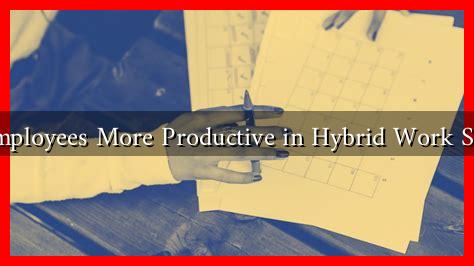-
Table of Contents
Are Employees More Productive in Hybrid Work Settings?
The COVID-19 pandemic has fundamentally altered the way we work, with many organizations adopting hybrid work models that blend remote and in-office work. As companies navigate this new landscape, a pressing question arises: Are employees more productive in hybrid work settings? This article explores the productivity implications of hybrid work, supported by research, case studies, and statistics.
The Rise of Hybrid Work Models
Hybrid work models have gained traction as organizations seek to balance flexibility and collaboration. According to a report by McKinsey, 52% of employees prefer a hybrid work model, which allows them to work both remotely and in the office. This shift has prompted companies to rethink their productivity metrics and workplace strategies.
Understanding Productivity in Hybrid Work Settings
Productivity can be defined in various ways, including output per hour worked, quality of work, and employee engagement. In hybrid work settings, several factors influence productivity:
- Flexibility: Employees often report higher job satisfaction and productivity when they have the flexibility to choose their work environment.
- Reduced Commute: Eliminating daily commutes can save employees time and reduce stress, leading to increased focus and efficiency.
- Work-Life Balance: Hybrid models can enhance work-life balance, allowing employees to manage personal responsibilities alongside their professional duties.
Case Studies and Statistics
Several organizations have reported positive outcomes from hybrid work models:
- Microsoft: In a study conducted by Microsoft, employees who worked in a hybrid model reported a 20% increase in productivity compared to their fully remote counterparts.
- Salesforce: Salesforce found that employees in hybrid settings were 30% more engaged than those working exclusively in the office.
- Buffer: Buffer’s State of Remote Work report indicated that 77% of remote workers felt more productive when working from home, a sentiment echoed in hybrid settings.
Moreover, a survey by Gartner revealed that 47% of organizations plan to allow employees to work remotely full-time, while 82% of company leaders believe that hybrid work will be the future of work. These statistics underscore the growing acceptance of hybrid work as a viable model for enhancing productivity.
Challenges of Hybrid Work
While hybrid work offers numerous benefits, it is not without challenges. Some potential drawbacks include:
- Communication Gaps: Hybrid settings can lead to miscommunication and feelings of isolation among remote employees.
- Technology Dependence: A reliance on technology for collaboration can create barriers if not managed effectively.
- Workplace Culture: Maintaining a cohesive workplace culture can be challenging when employees are split between remote and in-office settings.
Strategies for Enhancing Productivity in Hybrid Work
To maximize productivity in hybrid work settings, organizations can implement several strategies:
- Regular Check-Ins: Schedule regular one-on-one meetings to ensure employees feel supported and connected.
- Clear Communication Channels: Utilize tools like Slack or Microsoft Teams to facilitate seamless communication.
- Flexible Policies: Allow employees to choose their work hours and locations to accommodate personal preferences.
Conclusion
In conclusion, hybrid work settings can enhance employee productivity when implemented thoughtfully. The flexibility, reduced commute times, and improved work-life balance contribute to higher job satisfaction and engagement. However, organizations must also address the challenges that come with this model, such as communication gaps and maintaining workplace culture. By adopting effective strategies, companies can harness the benefits of hybrid work and create a productive environment for their employees.
As we move forward, it is essential for organizations to remain adaptable and responsive to the evolving needs of their workforce. For further insights on hybrid work and productivity, consider exploring resources from Gartner and McKinsey.


